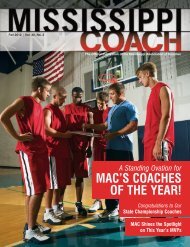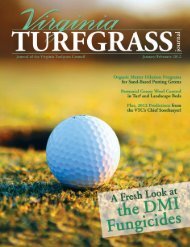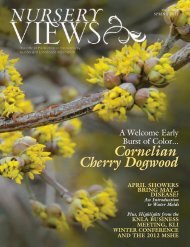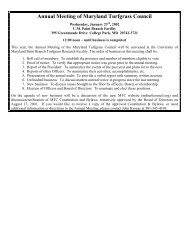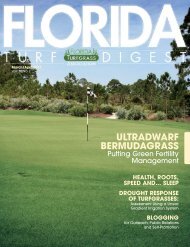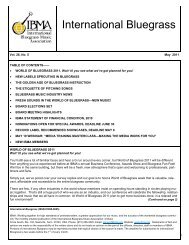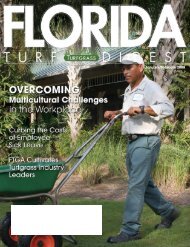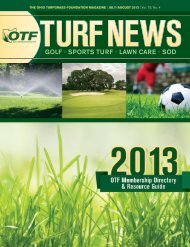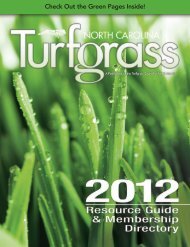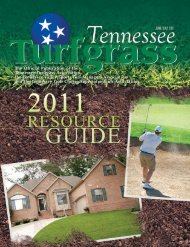Nursery Notes Nov-Dec 2011 - The Paginator
Nursery Notes Nov-Dec 2011 - The Paginator
Nursery Notes Nov-Dec 2011 - The Paginator
Create successful ePaper yourself
Turn your PDF publications into a flip-book with our unique Google optimized e-Paper software.
Exotic Ambrosia Beetles a Constant Threat<br />
to North Carolina Trees<br />
Dr. Steven Frank, NCSU<br />
Every year I run ambrosia beetle traps at nurseries throughout<br />
the state. <strong>The</strong> primary purpose of this activity is to<br />
determine when granulate ambrosia beetles become active<br />
so I can send growers alerts via email and Twitter. In reviewing<br />
the beetles captured this year we can across an unusual specimen:<br />
the banded elm bark beetle, Scolytus schevyrewi. This beetle<br />
is native to China and surrounding areas. Since 2003, when it<br />
was first detected in the US, it has spread throughout the west.<br />
However, this was the first report of the beetle in North Carolina.<br />
In Asia banded elm bark beetles attack Ulmus species but also<br />
trees in the legume and rose families. <strong>The</strong> impact of this species<br />
on US nursery and landscape industries is not fully understood<br />
but large numbers of elm street trees have been killed in western<br />
states. In addition, it has been found to vector Dutch Elm disease.<br />
Another first this year was detection of the redbay ambrosia<br />
beetle in coastal areas of the state. Although not likely a threat to<br />
nurseries this beetle has decimated redbay trees in Georgia and<br />
South Carolina where redbays are the dominate tree species in<br />
some coastal ecosystems. Significant concern exists for avocado<br />
orchards in Florida since avocado is closely related to redbay and<br />
has been shown to be a suitable host.<br />
Another ambrosia beetle recently detected in North Carolina<br />
and other Southeast States is the Camphor Shot Borer,<br />
Xylosandrus mutilatus. This beast is many times larger than the<br />
granulate ambrosia beetle that has caused so much trouble in<br />
recent decades. It attacks live and recently dead trees including<br />
Acer sp., Cornus sp, and other nursery and landscape trees.<br />
Again, this is an emerging exotic threat and the true potential for<br />
economic damage will not be known for some time.<br />
Finally, Xylosandrus germanus, which is very similar to granulate<br />
ambrosia beetle, X. crassiusculus, seems to be shifting its<br />
range. It has typically been a northern pest whereas X. crassiusculus<br />
has been a comparable southern pest. Now X. germanus is<br />
turning up in our traps in NC and X. crassiusculus is becoming<br />
more common in the Northeast and Midwest. Since this species is<br />
so similar to our beloved granulate ambrosia beetle it may have<br />
minimal additional impact. However, differences in seasonal activity<br />
or preferred species could increase the duration trees need protection<br />
or the number of species that need to be sprayed. Either<br />
one would have an economic impact on NC nursery growers.<br />
14 • <strong>Nursery</strong> <strong>Notes</strong><br />
Banded Elm Bark Beetle, Scolytus schevyrewi. Photo: Pest and Diseases<br />
Image Library, Australia<br />
Camphor Shot Borer, Xylosandrus mutilatus. Photo: Doug Stone,<br />
Mississippi State University.<br />
Many odd things happen when a species invades a new range.<br />
<strong>The</strong>y often switch hosts or switch from attacking dead trees to<br />
live trees for reasons we do not fully understand. <strong>Nursery</strong> stock is<br />
particularly susceptible because it is live but to beetles it can<br />
See Ambrosia Beetles – continued on page 16




